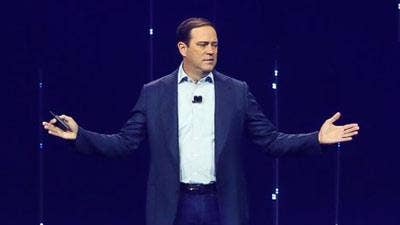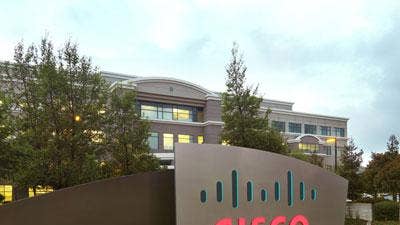Cisco CEO Robbins On The Channel's Place In An Open, Developer-Oriented Cisco, And Advancing 'Something Hugely Different Than Anything We've Ever Done Before'
Cisco CEO Chuck Robbins speaks with CRN at Cisco Live and discusses how partners can use the DNA Center Platform to develop applications for customers and why the Catalyst 9000 switch is the fastest-ramping product in Cisco's history.

Good Intentions
Chuck Robbins' drive to develop the company's intent-based networking strategy is breaking opportunities for partners wide open, the Cisco Systems chairman and CEO said.
The San Jose, Calif.-based networking giant, which has dominated the hardware routing and switching market for decades, is this week emphasizing network programmability, application development, DevOps and open APIs as it aims to position itself as the industry's pre-eminent open networking platform vendor.
Partners of the new Cisco have the opportunity to use the new, open DNA Center Platform to develop applications for customers, Robbins told CRN in an interview at the Cisco Live conference in Orlando, Fla.
Cisco introduced its intent-based networking strategy about a year ago, and since then the subscription-based Catalyst 9000 switch, which is the foundation of the strategy, has been sold to 5,800 customers, Robbins said, making it the fastest-ramping product in Cisco's history.
What follows is an edited excerpt of Robbins' conversation with CRN.

App development, DevOps, network programmability; these are big developments for Cisco. How is Cisco bringing its channel partners along on this journey, and how are partners helping Cisco come along on the same journey?
As we've gone through different technology transitions, the way our partners have generated profits has evolved. The thing I particularly like about the current transition around opening up programmability of our technology is it gives partners the ability to actually create unique – their own proprietary – IP. That gives them the capability to add value not only to the customer, but also to create a competitive advantage for them and not get into discussions all around pricing and things we all face in the marketplace. There will still be pricing pressure, but giving them the ability to build their own intellectual property on top of our platforms is a huge difference. We have partners who have acquired and/or built development teams that have built some of the early apps, and it really is impressive.

How do you rectify competing sales motions between the intent-based networking side of the business and the legacy hardware side of the business?
We have to make sure we're meeting our customers where they are in this journey. This intent-based networking transition is going to be a multiyear transition. Customers and partners are going to be at different points in the life cycle. We had Children's Hospital of Los Angeles on stage this morning. They've gone all- n, and they've seen such a huge benefit from the technology today. We have other customers that may not look at it for another year. We'll see customers along that journey, and our teams need to be able to engage with those customers at whatever point they are in the life cycle.

As you push ahead with the intent-based networking strategy, how are you seeing channel partners evolve their skill sets?
Intent-based networking provides multiple opportunities for our partners. While the end-state is incredibly valuable for our customers, getting there requires some planning and some new capabilities. When you talk about automating the configuration and provisioning of the network as opposed to going into command line, there's a whole set of skills and capabilities that need to be present. Our partners can provide those capabilities to help our customers build to a place where they can do it. We'll have solutions where our partners can offer a managed intent-based networking solution for our customers. If you're looking at things like Assurance, it's having our partners provide those types of services and then help the customers evolve their infrastructure based on what we're learning from the Assurance capabilities.
What are the key challenges for Cisco in developing intent-based networking to make sure it delivers on the promises you're making about it?
When you look at what our teams have done over the last three years, first and foremost they had to rewrite our entire enterprise operating system. That's 30 years of code that they rewrote to a modern data model, API structured operating system and they did a phenomenal job. You heard a customer talking this morning about how seamless the implementation has been. The other important thing is staying very focused on a few use cases that are very high value early on. That's why software-defined access is so important. It is one of the biggest problems that our customers are trying to solve, then equally focusing on network assurance, which is another thing that our customers see huge value in. Staying focused early on, and not trying to boil the ocean too much, but at the same time, the other thing that is really important is when our team built this new operating system that enables DNA Center, they made it backward-compatible with one or two generations of ISRs, wireless access points, campus switches, so customers can deploy it in a brownfield environment, as well.
How does DNA Center Platform position, or reposition, Cisco in the market?
DNA Center as a Platform really opens up that ability for our partners to build incremental intellectual property. Providing a set of APIs that customers and partners can then write their own applications, that take advantage of the information we can extract from the network, or dynamically can initiate a provisioning activity inside the network, this is hugely different than anything we've ever done before. I started my career as an application developer. Now here I am, I'll say a few years later, and the application and the technology I've been working on for the last 25 years are actually coming together in a way they never have. It's hugely impactful. Customers are going to love it. I think our partners are going to love it, and they're going to find great ways to monetize it.

It's hugely different for Cisco. How big of a differentiator do you think it will be in the market for Cisco versus HPE or Dell EMC or any other competitors?
The real differentiator for us is our years and years and years of understanding networks. You can't go build these complex automation platforms and expose those northbound APIs if you don't understand what's happening in the network in an incredibly deep way, and we understand that better than anybody else. The second thing is we have a significant install base out there that is really going to be the focus of our customers. They will want to add new technology where they need it, but they'll want to automate the new and what's existing in their infrastructure that is still under support that can run their operating system. Many of these players that are moving into this space either have limited capabilities across multiple vendors, or they might have a new piece of hardware that their automation platform works on, but it doesn't really do anything for anything else in the network. No customer wants four or five of these platforms to run the network. That's a big differentiator for us, and I think our teams were quite smart to make the architecture backward-compatible for a generation or two.
Where are you as far as the integration of Broadsoft is concerned, and how should channel partners be thinking about that?
We closed Broadsoft a few months ago and the teams are working through the integration. We always want to do these in a way that doesn't disrupt the positive momentum that in this case Broadsoft has. We begin to build our strategies for how we can integrate the two technologies together, or our portfolio and theirs. I think we're in that mode where we're trying to accelerate their model through our go-to-market and our partnerships, and at the same time looking at what are the road maps for us to bring these technologies together. Our partners – particularly our service providers – hopefully we can bring them more capabilities that they can sell to the 20 million users that are on this platform today.

What's your strategy for hosted collaboration? Do you think Cisco will take over the cloud PBX market like it did with on-prem?
What we believe in is making sure our customers have choice. There's not one solution, or one method of consuming the technology that every customer is going to want to do. Even DNA Center -- we have customers who are going to want it on-premise. We have customers that are saying when you offer a multitenant version from the cloud, then I'll consume it that way. I think collaboration and other technologies are quite similar. I think you'll see us continue to position our portfolio through various methods so that customers can consume it however they like.

What are you seeing in the market broadly that's working in Cisco's favor?
In general, the global economic situation is probably, despite a lot of geopolitical noise right now, as favorable from a consistency perspective as we've seen in a very long time. From a technology perspective, the transition we see with the network and the relevance of the network; the architecture our customers are going to have to build to deal with this explosion of data at the edge, public cloud services, SaaS services, private data centers, the network is at the heart of that, and the network really is going to have to create and deliver more services and more security and capabilities. Over time, the new architecture that our customers are going to build is actually in the sweet spot of enabling the network to actually do more in the future.

How much of the innovation we're seeing from Cisco is Cisco pushing customers in that direction, and how much is customers pulling you along?
I'd like to think that almost all of it is coming out of a customer engagement. Even the things that we build, I wouldn't say we push customers along. We listen to our customers and we understand the challenges they're trying to solve for and then we try to bring our innovation to try to help solve those issues and help them achieve the objectives they have. In the last two years, we have had many instances where we've had customers come to us with a more specific idea of what they need us to do. That's this whole idea of co-innovation, co-development that we've come out with. When you work with an advanced, mature customer on a solution and you iterate through the process, you feel pretty good about the product. When they represent thought leadership in a given industry, what you find is that all of them want us to productize these solutions and sell them. They don't want bespoke solutions. Those solutions resonate with other customers in that industry.

Do you feel like you have your executive leadership team where you want it to be?
I am incredibly happy with our executive leadership team. Nobody's talked about it much, but actually 55 percent of my direct leadership team are females in Silicon Valley, which is unusual. Think about the quality of people who have joined our team recently with Maria Martinez, who was president of customer success at Salesforce, and is now leading our customer experience organization; Geri Elliott, who was at Microsoft, Juniper and has lots of public board experience, is running our sales and marketing team. Amy Chang coming in brings an incredible amount of energy and passion and understanding of AI and big data sets and software, in addition to the broader team we have had in place, I'm incredibly excited about the team we have right now.

What are the conversations you're having around your biggest enterprise customers who are always looking to drive costs out, including out of the network?
That's exactly the discussion we're having with them right now. For many, many years, these discussions were always focused on the cost of hardware. Now the focus has shifted to the cost of operating this technology. When you look at the fact that for every $1 you spend on an Ethernet switch, you spend $15 operating it over the course of five years, that's where the savings are. If you look at DNA Center and the technology we're bringing forward, we're solving for security, we're solving for operational simplicity. These are the things these customers care about. They're deeply ingrained in working with us to make sure these solutions meet their needs, and I think we are attacking the cost in their infrastructure.